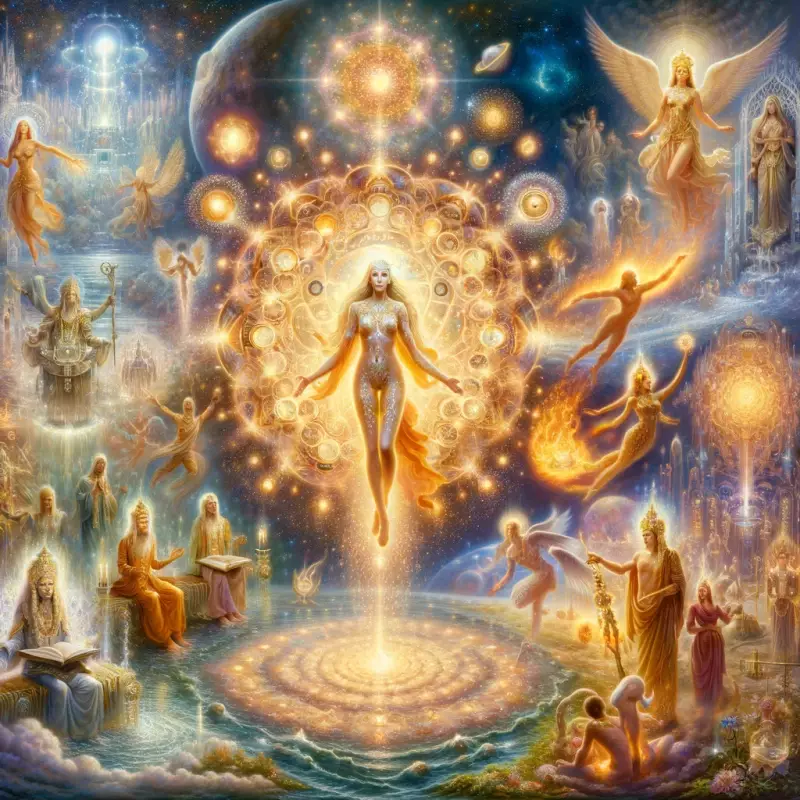23. Celestial Plane (Swarga-Loka)

Affirmation:
I connect with the divine harmony and peace of the heavenly plane.
With a pure mind and elevated intentions, I live in joy, grace, and infinite light, bringing Heaven to Earth.
Mantra:
Om Swarga Jyoti Namah
23
Celestial plane
(swarga-loka)
Swarga-loka, the heaven world, is the third loka of the seven planes of existence. These three—bhu-loka, bhuvar-loka, and swarga-loka belong to a category of planes that perish at the end of a day of creationa day of the Creator, Brahma—and are reborn with the dawn of the succeeding day. On bhu-loka, the physical plane, all exists on a physical level; on bhuvar-loka, the astral plane, the desires are at work; and on swarga-loka, the celestial plane, work is carried out at the level of thoughts. On this plane the fire element is the ruling power, and all that exists on this level of existence is made up of particles of fire — luminous, lustrous particles of light — and that is why the beings in swarga-loka are self luminous. Shining angels and gods are mentioned everywhere in all mythologies.
In the first chakra the player longed for security and sought possessions that would protect and nurture him. In the second chakra he explored the world of the senses and strove for sensual gratification. On reaching the level of the third chakra he begins to see beyond the material and sensual realms and to fathom the nature of his ego, his personal identity. So here the concern is that of providing immortality for his identity-construct.
Once this desire for ego-immortality springs into his heart, the celestial laws attract his attention as he tries to fashion for himself a heaven from his own desires. The heaven he conceives is a plane full of all that his self requires for pleasure, joy, and happiness. He realistically sees the world as full of pain and suffering, rises and falls. He craves a pleasure that is infinite, without cessation or variation. This is the space known as heaven, nurtured by the religions of all peoples. Even Marx, that atheistic third-chakra philosopher, could not do without a heaven. He called his ultimate goal the classless society.
Heaven is a manifestation of third-chakra desire. If we detach ourselves from value judgments we can see it as a genuinely higher plane, one attained from the second chakra by purification. Heaven is the lure used to sway errant first- and second-chakra sheep back into the spiritual fold, and it has been used by saints and prophets of all religions to raise the spiritual level of the masses.
In the Hindu tradition heaven is the domain of Indra. He is the one who has mastered his indryas. the five organs of perception and the five organs of action. One who masters these organs becomes lord of Heaven and dwells in this space. Heaven is the dwelling place of saints, bhaktas (spiritual devotees), high karma-yogis, and the celestial dancers and musicians (see square 11).
To one who has mastered his organs of perception and action, everything exists as it does on the physical plane but in harmonious and divine form. There are no lower desires, no violence, no attachment, no greed, no jealousy, no avarice, no anger, no sensuality, no nullity. There exist instead purification, recreation, mercy, joy, and an infinite life to enjoy. Heaven is the edifice constructed with the scaffolding of dharma.
Art
This rendition of the "Celestial Plane" (Swarga-loka) artwork brings to life Swarga-loka as a realm of radiant light, dominated by the element of fire, in a more lifelike manner. The beings, such as shining angels and gods, are depicted in a realistic style, appearing as self-luminous entities composed of lustrous particles of light. The background features a realistic celestial landscape, capturing the harmonious and divine atmosphere of this plane. Higher virtues like purification, recreation, and joy are subtly integrated, enhancing the spiritual ambiance. Realistic representations of Indra, the lord of heaven, along with celestial dancers and musicians, underscore the spiritual significance of Swarga-loka. The overall composition portrays Swarga-loka as a serene and divine realm, achieved through spiritual elevation and mastery over the senses.
Song
Celestial Plane
Swarga-loka, realm of light, a celestial domain,
Third plane of seven, taking flight, where thoughts begin to reign.
Saints and prophets, wise and old, uplift the masses' soul,
With stories of a future bold, where suffering takes no toll.
Ego's take the stage, a playground of their own,
Pleasures without end, are promised yet unknown.
Religion's stories softly call, of heavens bright and grand,
A comfort for those who believe, in this celestial land.
Click the die of karma.
Then click the corresponding number to advance.
1 - 2 - 3 - 4 - 5 - 6
Leela (Eng) - TheLifeArtist.org - Healing Earth.org
1 - 2 - 3 - 4 - 5 - 6 - 7 - 8 - 9 - 10 - 11 - 12 - 13 - 14 - 15 - 16 - 17 - 18 - 19 - 20 - 21 - 22 - 23 - 24 - 25 - 26 - 27 - 28 - 29 - 30 - 31 - 32 - 33 - 34 - 35 - 36 - 37 - 38 - 39 - 40 - 41 - 42 - 43 - 44 - 45 - 46 - 47 - 48 - 49 - 50 - 51 - 52 - 53 - 54 - 55 - 56 - 57 - 58 - 59 - 60 - 61 - 62 - 63 - 64 - 65 - 66 - 67 - 68 - 69 - 70 - 71 - 72

